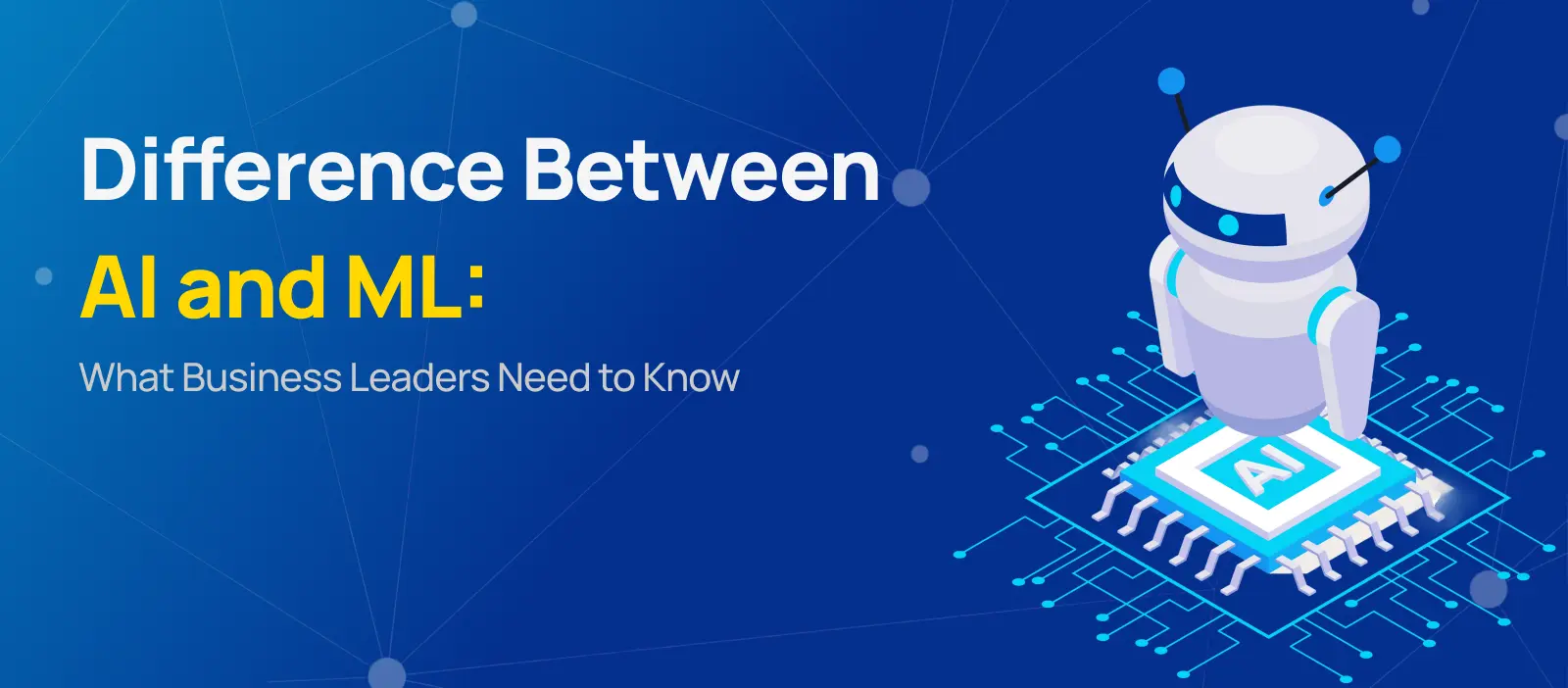Difference Between AI and ML: What Business Leaders Need to Know
October 21, 2025

Here’s something that’s going to save you from making a very expensive mistake: Most business leaders can’t explain the difference between AI and ML – and it’s costing them millions in misaligned tech investments.
Last month, a CEO invested $ 200,000 in an “AI solution” that was essentially just basic automation with clever marketing. Six months later, they’re still waiting for the revolutionary insights they were promised.
Sound familiar?
What is the difference between AI and ML for business isn’t just a technical question – it’s a strategic one. The companies getting this right are making smarter investments, seeing better ROI, and building sustainable competitive advantages.
The ones getting it wrong are burning cash on buzzword-heavy solutions that don’t deliver.
What is AI in Business?
AI in businesses is a problem solver that can tackle challenges beyond human capabilities, faster and more efficiently.
Artificial intelligence in a business context means systems that can perform tasks typically requiring human intelligence, such as understanding language, recognizing patterns, making decisions, and solving complex problems.
But here’s what truly impacts your profit and Loss is this: AI drives value by handling tasks that were previously impossible to scale. It’s not about speed; it’s about accomplishing what humans couldn’t do.
Real AI tools for business are mostly used as:
- Customer service chatbots that understand context and emotion.
- A Fraud detection system for identifying suspicious patterns instantly.
- On-demand forecasting considering all the factors.
- Personalized engine tailored for individual requirements.
The key insight? AI is about augmenting human decision-making, not just automating routine tasks.
What is ML in Business?
Machine learning in businesses is the process of making your data smarter every day.
If AI is the brain, ML is the learning mechanism. It is a refined algorithm that makes the brain smarter with experience. Finding patterns in your data and making predictions that improve over time is an ML application in business.
Here’s the business impact: ML turns your historical data into a future competitive advantage.
Common predictive analytics for business applications:
- Sales forecasting that gets more accurate each quarter
- Inventory optimization that reduces carrying costs while avoiding stockouts
- Customer churn prediction that identifies at-risk accounts before they leave
- Price optimization that maximizes revenue based on market conditions
The difference? ML doesn’t just solve problems – it learns from every solution to get better at solving future problems.
Key Differences Between AI and ML for Enterprises
As we spoke before, AI is the brain, and ML is the learning mechanism. But let’s dive deep.
AI is like hiring a consultant: You hire people to solve specific problems using their expertise and judgment.
ML is like training your existing team: You are building internal capabilities that improve over time.
This is the basic difference between them. Now, let us compare other dimensions.
Scope and Purpose:
- AI: Used for broad problem-solving across multiple business functions.
- ML: Designed for specific pattern recognition and prediction tasks.
Implementation Complexity:
- AI: Often requires significant infrastructure and integration.
- ML: Can start small with existing data and scale gradually.
ROI Timeline:
- AI: Can deliver immediate impact but requires a larger upfront investment.
- ML: Shows gradual improvement with compounding returns over time.
Resource Requirements:
- AI: It needs diverse skill sets and often external expertise.
- ML: Requires data quality focus and domain knowledge to run efficiently.
The relationship between AI and machine learning in enterprises is symbiotic. ML powers many AI capabilities, while AI provides the framework for ML applications.
AI vs ML in Real-World Business Use Cases
Though there are many applications across multiple industries, let’s look into a few of them.
Finance:
- AI: A personalized investment strategy for everyone.
- ML: Credit scoring models that improve with each loan decision.
- AI: Diagnostic systems that analyze medical images with superhuman accuracy
- ML: Treatment recommendation engines that learn from patient outcomes
Retail:
- AI: Virtual shopping assistants that understand customer preferences
- ML: Dynamic pricing algorithms that optimize for demand and competition
Manufacturing:
- AI: Quality control systems that identify defects that human inspectors miss
- ML: Predictive maintenance that prevents equipment failures
The pattern? AI vs ML use cases in business often complement each other – AI handles complex decision-making while ML provides the learning foundation.
Learn more about how AI agents help you with the software development workflow.
Common Mistakes Businesses Make When Choosing AI vs ML
Here are the expensive mistakes businesses should avoid:
Mistake #1: Losing focus on why AI. Many companies are investing in AI because competitors are, without understanding the specific business problems it should solve.
Mistake #2: Data Unreadiness Implementing ML without clean, organized data – like trying to train an employee with incomplete information.
Mistake #3: Expecting Magic. Believing AI will solve problems that require fundamental business process improvements.
Mistake #4: Underestimating Change Management. Focusing on technology while ignoring how AI-driven apps and ML systems will change workflows.
Mistake #5: ROI Mismeasurement. Using traditional metrics instead of understanding how AI vs ML for business decision-making creates value differently.
How to Decide: AI or ML for Your Business?
Go through the checklist below and decide which one you want first.
Start with ML if:
- You have specific, data-rich problems to solve
- You want to improve existing processes gradually
- Your team can identify clear patterns in historical data
- You prefer lower-risk, incremental improvements
Start with AI if:
- You need to solve complex, multi-faceted problems
- You want to create entirely new capabilities
- You have a budget for comprehensive solutions
- Your competitive advantage depends on breakthrough innovations
Go with Both if:
- You’re building enterprise AI solutions for long-term competitive advantage
- You have a mature data infrastructure and skilled teams
- Your industry is being disrupted by intelligent automation
The smartest approach? How AI and ML help businesses improve operations is often through integrated solutions that combine both technologies strategically.
Future of AI and ML in Business
The trajectory is clear: AI and ML applications for enterprises are becoming infrastructure, not luxury add-ons.
AI Evolution:
- More intuitive interfaces that require less technical expertise
- Industry-specific solutions that deliver faster ROI
- Integration with business intelligence AI for strategic decision-making
ML Advancement:
- Automated model building that democratizes predictive analytics
- Real-time learning that adapts to changing business conditions
- Edge computing that enables ML in low-latency environments
Convergence Trends:
- AI app development incorporating ML capabilities by default
- Process automation is becoming more intelligent and adaptive
- Data-driven decision making evolving into an AI-augmented strategy
The companies winning long-term aren’t just using AI or ML – they’re building learning organizations where both technologies amplify human intelligence.
Conclusion
The difference between AI and ML isn’t just technical trivia – it’s strategic intelligence that separates smart investments from expensive mistakes.
AI solves complex problems that humans can’t handle at scale. ML turns your data into continuously improving competitive advantages. Most successful implementations use both, but in different ways and timelines.
The businesses thriving in 2025 understand this distinction and use it to make better technology investments. While their competitors are still debating whether to “do AI,” these companies are already seeing measurable results from strategically deployed intelligent systems.
Your next competitive advantage is waiting in your data and processes. The question isn’t whether you’ll eventually implement AI and ML – it’s whether you’ll do it strategically or reactively. Or leverage AI/ML services from thriving businesses.
The choice is yours. But choose with understanding, not buzzwords.
FAQs
What is the main difference between AI and ML?
AI (Artificial Intelligence) is the broader concept of machines performing tasks that typically require human intelligence, while ML (Machine Learning) is a subset of AI that (Machine Learning) is a subset of AI that focuses on systems learning and improving from data without explicit programming.
Which is better for business: AI or ML?
Neither is inherently “better” – they serve different purposes. ML is ideal for data-driven predictions and pattern recognition, while AI excels at complex problem-solving and decision-making. Most successful businesses use both strategically.
Can you have AI without ML?
Yes, AI can exist without ML through rule-based systems and expert systems. However, modern AI applications typically incorporate ML to improve performance and adapt to new situations.
Is machine learning part of artificial intelligence?
Yes, machine learning is a subset of artificial intelligence. AI is the umbrella term, while ML is one of the methods used to achieve AI capabilities, along with other approaches like natural language processing and computer vision.
Do I need both AI and ML for my business?
It depends on your specific needs. Start with ML if you have data-driven problems to solve, or AI if you need comprehensive intelligent solutions. Many businesses begin with one and expand to integrated approaches as they mature.
Keep reading about
LEAVE A COMMENT
We really appreciate your interest in our ideas. Feel free to share anything that comes to your mind.
Our 16 years of achievements includes:
10M+
lines of codes
2400+
projects completed
900+
satisfied clients
16+
countries served




